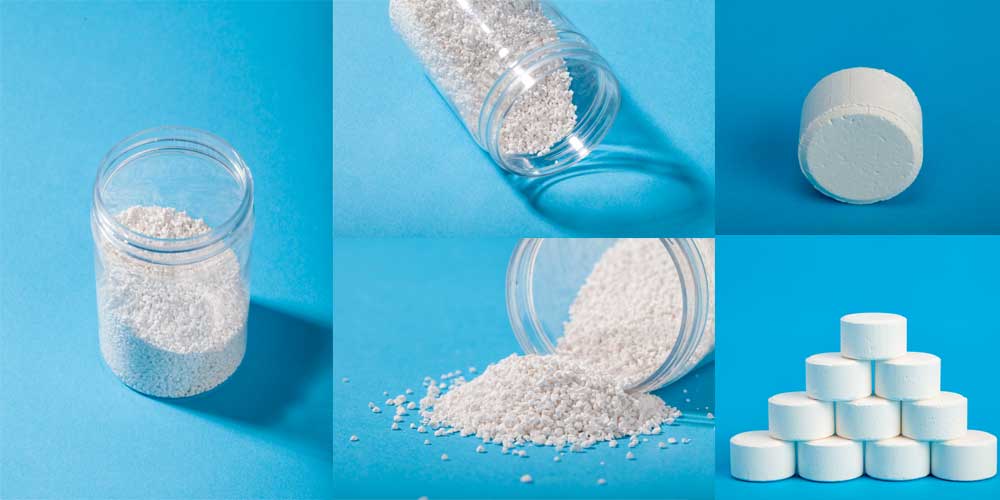සෝඩියම් ඩයික්ලෝරෝසොසයොසයිට්රේට්(SDIC හෝ NADCC ලෙසද හැඳින්වේ) සහ සෝඩියම් හයිපොක්ලෝරය ක්ලෝරීන් මත පදනම් වූ විෂබීජ නාශක සහ පුළුල් ලෙස භාවිතා කරයිරසායනික විෂබීජ නාශකපිහිනුම් තටාකයේ. අතීතයේ දී, සෝඩියම් හයිපොක්ලෝරයිට් යනු පිහිනුම් තටාක විත්තන්ෂය සඳහා බහුලව භාවිතා වන නිෂ්පාදනයක් වූ නමුත් ක්රමයෙන් වෙළඳපොළෙන් away ත් විය. SDIC ක්රමයෙන් එහි ස්ථාවරත්වය සහ ඉහළ මිල කාර්යක්ෂමතාවයේ effective ලදායී අනුපාතය නිසා ක්රමයෙන් ප්රධාන පිහිනුම් තටාක විෂබීජ නාශක බවට පත්ව ඇත.
සෝඩියම් හයිපොක්ලෝරයිට් (නෝක්)
සෝඩියම් හයිපොක්ලෝරය සාමාන්යයෙන් කහ-කොළ පැහැති ද්රවයක් වන අතර තද ගන්ධයක් සහිත කහ පැහැති දියර වන අතර වාතයේ කාබන් ඩයොක්සයිඩ් සමඟ පහසුවෙන් ප්රතික්රියා කරයි. මක්නිසාද යත් එය ක්ලෝර්-අල්කාලි කර්මාන්තයේ අතුරු product ලයක් ලෙස පවතින බැවින් එහි මිල සාපේක්ෂව අඩුය. සාමාන්යයෙන් පිහිනුම් තටාක විත්තන්ණය සඳහා එය සාමාන්යයෙන් දියර ස්වරූපයෙන් දියර ස්වරූපයෙන් එකතු වේ.
සෝඩියම් හයිපොක්ලෝරයේ ස්ථායිතාව ඉතා අඩු හා පාරිසරික සාධක මගින් බෙහෙවින් බලපායි. ආලෝකය සහ උෂ්ණත්වය යටතේ කාබන් ඩයොක්සයිඩ් හෝ ස්වයං දිරාපත් වීම හරහා දිරාපත් වීම පහසු වන අතර සක්රීය අමුද්රව්යවල සාන්ද්රණය මෙතරම් ඉක්මනින් අඩු වේ. උදාහරණයක් ලෙස, බ්ලීච් කිරණ ජලය (සෝඩියම් හයිපොක්ලෝරයිට් හි වාණිජ නිෂ්පාදනය) දින 60 කින් පවතින ක්ලෝරීන් අන්තර්ගතයෙන් 18% ක් ලබා ගත හැකි චලයින් වලින් අඩක් අඩු වේ. අංශක 10 කින් උෂ්ණත්වය වැඩි වුවහොත්, මෙම ක්රියාවලිය දින 30 ක් දක්වා කෙටි වේ. එහි විඛාදන ස්වභාවය නිසා ප්රවාහනයේදී සෝඩියම් හයිපොක්ලර් කාන්දු වීම වැළැක්වීම සඳහා විශේෂ සැලකිල්ලක් අවශ්ය වේ. දෙවනුව, සෝඩියම් හයිපොක්ලෝරයිට්ගේ ද්රාවණය දැඩි ලෙස ක්ෂාරීය හා තදින් ඔක්සිකරණය වන නිසා, එය ඉතා පරිස්සමින් හැසිරවිය යුතුය. නුසුදුසු හැසිරවීම මඟින් සම විඛාදනයට හෝ අක්ෂි හානියට හේතු විය හැක.
සෝඩියම් ඩයික්ලෝරෝසොසයොසයිට්රේට්(SDIC)
සෝඩියම් ඩයික්ලෝරෝසොසයිටිස් සාමාන්යයෙන් සුදු කැටිති වන අතර එය ඉහළ ස්ථාවරත්වයක් ඇත. සාපේක්ෂව සංකීර්ණ නිෂ්පාදන ක්රියාවලිය හේතුවෙන්, මිල සාමාන්යයෙන් නාඕක්ට වඩා වැඩි ය. එහි විෂබීජ නාශක යාන්ත්රණය වන්නේ ජලීය ද්රාවණයක හයිපොක්ලෝරයිට් අයන මුදා හැරීම, බැක්ටීරියා, වෛරස් සහ ඇල්ගී විනාශකාරීව killing ාතනය කිරීම. ඊට අමතරව, සෝඩියම් ඩයික්ලෝරෝිසොසයොසයොසයොසයිටවුන්රට වර්ණාවලි ක්රියාකාරිත්වයක් ඇති අතර, විභව ක්ෂුද්ර ජීවීන් effectively ලදායී ලෙස ඉවත් කර පිරිසිදු හා සනීණාත්මක ජල පරිසරයක් නිර්මාණය කරයි.
සෝඩියම් හයිපොක්ලර් සමඟ සසඳන විට, එහි විෂබීජහරණය කාර්යක්ෂමතාව හිරු රශ්මියෙන් පීඩාවට පත් වේ. සාමාන්ය තත්වයන් යටතේ එය ඉතා ස්ථාවර ය, දිරාපත් වීමට පහසු සහ ආරක්ෂිතව සිටීම පහසු නොවන අතර, ආරක්ෂා කිරීම, කාර්යක්ෂමතාව විෂබීජහරණය නැතිව වසර 2 ක් ගබඩා කළ හැකිය. එය solid න, එබැවින් ප්රවාහනය, ගබඩා කිරීම සහ භාවිතය පහසු කිරීම පහසුය. SDIC ට අඩු පාරිසරික බලපෑමක් ඇති අතර, අකාබනික ලවණ විශාල ප්රමාණයක් අඩංගු විරංජනයකට වඩා. එය භාවිතයෙන් පසු හානිකර අතුරු නිෂ්පාදන බවට පත්වන අතර පරිසර දූෂණය වීමේ අවදානම අඩු කරයි.
සාරාංශයක් ලෙස, සෝඩියම් ඩයික්ලෝරෝිසොසයොසයොසයෝසයිටිස් සෝඩියම් හයිපොක්ලෝරයිට් වලට වඩා කාර්යක්ෂම හා පරිසර හිතකාමී වන අතර ස්ථාවරත්වය, ආරක්ෂාව, පහසු ගබඩා කිරීම සහ ප්රවාහනය සහ භාවිතයේ පහසුවෙහි වාසි ඇත. අපගේ සමාගම ප්රධාන වශයෙන් විවිධාකාර උසස් තත්ත්වයේ සෝඩියම් ඩයික්ලෝරෝසොසයොසොසයොසයොසයොසයිටිස් නිෂ්පාදන, විස්තර සඳහා SDIC හි SDIC කැනුක, SDIC ටැබ්ලට් යනාදිය ඇතුළත් වේ. කරුණාකර සමාගමේ මුල් පිටුව ක්ලික් කරන්න.
පශ්චාත් කාලය: අප්රේල් -15-2024

